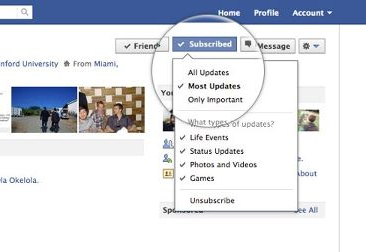
Until now, users could only “friend” one another on Facebook. Starting today, they'll also be able to "subscribe" to each other thanks to a new setting that allows individual profiles to behave more like Facebook fan pages.
A user will have the option of adding a "subscribe" button to her profile to enable people who are not her friends to see her public updates in their News Feeds, rather than having to visit her profile page directly. She will receive a notification when someone has signed up to see her updates, and will have the option of controlling who can comment on and "like" her posts.
“Some people who post publicly have a public presence and want to interact with people beyond their friends,” Naomi Gleit, director of product at Facebook, said. “This allows them to reach people beyond their friends.”In a blog post, Facebook suggested that "journalists, artists and political figures" might take advantage of the new tool. “If you see a Subscribe button on your favorite blogger’s profile, this means you can subscribe. Just click the button to get their public updates right in your News Feed,” Facebook wrote.
Though it remains to be seen how -- and if -- users will take to this feature, the subscribe button appears to have the potential to shift the social dynamic on Facebook by changing how people connect and how they communicate.
Facebook etiquette may redefined as people are forced to decide whether it’s more appropriate to “friend” someone they just met or merely "subscribe" to him. Is it too forward to "friend" a boss instead of "subscribing" to her? Is it creepy to "subscribe" to a girl you just met? Will you be offended if a colleague chooses not to "subscribe" to you after you "subscribe" to her?
Facebook’s new feature marks yet another effort to encourage people to share more on the social networking site, this time by carving out a new space for individuals to post information to a far broader audience than their friends. It enables Facebook to function more like Twitter and suggests an effort to encourage public figures to update Facebook the same way they tweet -- frequently, publicly, with breaking news or short musings. If "subscriptions" catch on, could it change the nature of what people share on Facebook? Rather than primarily viewing it as a platform for communication among friends, some users that had seen Facebook as a place for personal updates could transition from sharing to broadcasting.
The subscribe button is also an attempt to improve the relevance of what Facebook users see in their News Feeds. Not only can it be used to sign up to see posts by non-friends, but it will also enable users to fine-tune what information appears about their friends.
The tab, which will be visible at the top of all friends’ profile pages under the heading "subscribed," lets users tell Facebook to show more, less, or the same amount of information about a person.
"Until now, it hasn’t been easy to choose exactly what you see in your News Feed. Maybe you don’t want to see every time your brother plays a game on Facebook, for example. Or maybe you’d like to see more stories from your best friends, and fewer from your coworkers," Facebook wrote. "With the Subscribed button, you can choose how much you see from them."Facebook wants the status updates it displays to be interesting -- people will not return to the site as frequently if they’re shown posts from people they care little about -- and the subscriber tool enables Facebook to receive feedback on whose updates it should or should not include. Selecting "all updates" from a dropdown menu will tell Facebook you are interested in “everything" a friend posts; choosing "most updates" indicates you’re pleased with the status quo; and picking “only important” will limit the updates you view to major events.
“We want to give people more control over what people see in their News Feeds,” Gleit said. “Facebook is growing quickly and people have more and more friends, but they care about different people more or less, and different stories more or less.”
Post a Comment